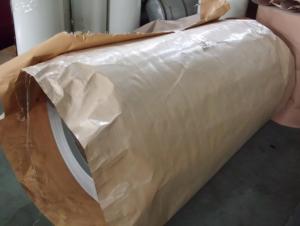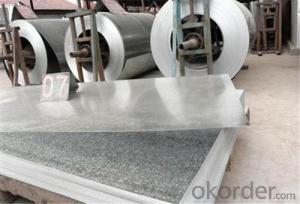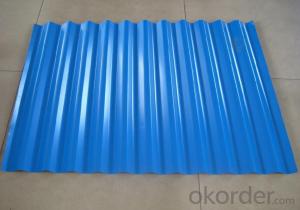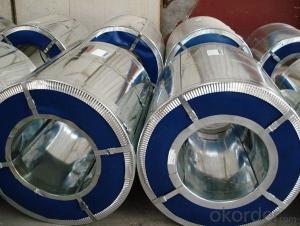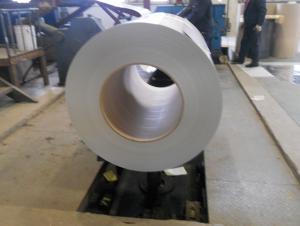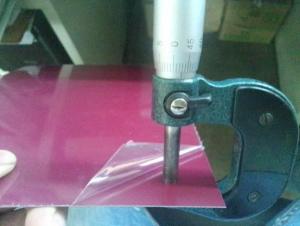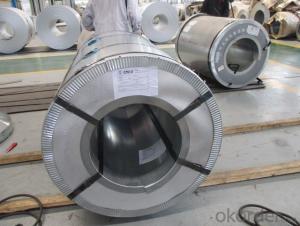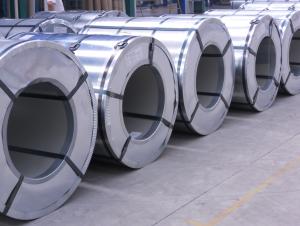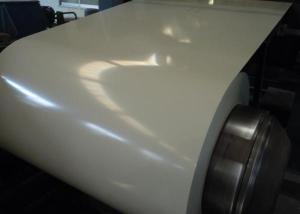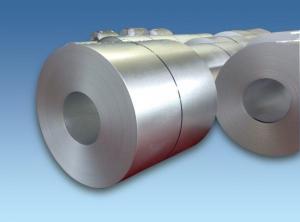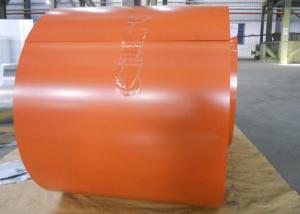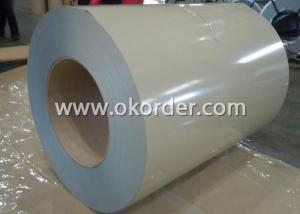Pre-painted Galvanized Steel Coil-JIS G 3312-RAL9003
OKorder Service Pledge
OKorder Financial Service
You Might Also Like
Pre-painted Galvanized Steel Coils/ PPGI/GI
I Specifications:
1.Thickness:0.16-2.0mm
2.Width:600-1500mm
3.Material: SGCC,SGCD,SECC,SECD,DX51D+Z
4.Zinc coating:40-275G/M2
5.Surface Structure: galvanized ,zero spangle, regular spangle or normal spangle
6.Surface treatment: chromated and oiled, chromated and non-oiled
7.Color:all RAL series
II Main characteristics :
1.strong corrosion resistance
2.surface quality
3.conducive to deep processing,such as the embossed PPGI,printed PPGI&punching PPGI
4.economy and practicality
III Applications:
Household Appliance:
1.Refrigerator shutter &side panels, Washer, Freezers, Air conditions,
2.Rice Cooker, Microwave Ovens, Water Heaters, Sterilization Cabinets, Range Hoods
3.Computer Panels , DVD/DVB panels, TV back panel etc.
Teaching Board: whiteboard, blackboard, green board(chalk board).
Indoor Decoration: Fireproof Door, kitchen cabinet, wall decoration.
Shipping Industries: Ship, Fecht, Marine.
Elevator/Medical Equipment/Rubbish Bin.
Thickness:0.17mm-0.8mm
Width:600mm-1250mm
Prepainted Galvanized Steel Coil
- Q: I've created something but it's a huge secret. Anyways I need to know everything and anything about steel. Like the iron steel. ANYTHING AND EVERYTHING. Best answer goes to the person with the most correct information. Please this is really important.
- If you want to know everything about steel, there's no way you're going to get an answer on Yahoo that is comprehensive enough. What you want to do is get some books on steel metallurgy, engineering properties of materials, and maybe machine design depending on your application. Topics will include molecular structure, material properties, alloying, stress and strain, work hardening, creep, computing damage and lifetime cycles, corrosion, toughness vs hardness, heat treating, and a ton of others. If you want to sharpen steel, that is a whole topic in itself concerning different blade profiles and their sharpness, edge holding, ease of sharpening, type of grind etc.
- Q: What are the safety regulations for handling steel coils?
- The safety regulations for handling steel coils typically include wearing appropriate personal protective equipment (PPE), such as gloves, safety glasses, and steel-toed boots. Additionally, workers are often required to receive proper training on safe lifting techniques and use of equipment, as well as understanding the weight and dimensions of the coils being handled. It is important to ensure a clear and organized work area, secure stacking and storage practices, and the use of appropriate lifting equipment, such as cranes or forklifts, to minimize the risk of accidents, injuries, and damage to the coils or surrounding infrastructure.
- Q: Can steel coils be recycled?
- Yes, steel coils can be recycled. Steel is a highly recyclable material, and the recycling process for steel coils involves melting them down and reshaping them into new products. This helps conserve natural resources, reduce energy consumption, and minimize waste.
- Q: I made a wood crossbow body but all I need is a bow which I want to be metal. I've used a thin steel sheet that I cut to appropriate size but when it bent with the string strung, it never went to original shape after being shot. I used a slightly thicker and it wouldn't bend at all. Anybody know what thickness and type to use? Any real answers are very appreciated. Thanks.
- So i do know way more about compound bows than I do about crossbows, but i'm going to enterprise an opinion. For my part, i would probably lean toward the compound bow. A part of it's only that i like them higher. However, moreover to that, more often than not when you find yourself hunting you will carry the crossbow loaded, on the grounds that the are typically awkward to load when you have the shot. If you're hunting from a blind or from a tree stand (and might figure out easy methods to load the item whilst you're up there) that's almost always ok. But when you need to tote a crossbow round whilst it's loaded, that may be a bit dicier proposition. Most crossbow safeties are lovely crude making the likelihood of by chance firing one alot bigger than with a rifle. Now, to the plus facet, a crossbow has essentially the entire upside of firing a rifle - best accuracy, same ergonomics, can run a scope on them. Without the downside - no real recoil, no longer too loud and you simply have a lovely excellent trigger on about any of them. Compounds are way more work. Plus it is much tougher to be accurate under stress with a compound than a crossbow. Regarding the protection? Don't particularly find out about that. After I was once doing shooting alot of archery, my 3 - D bow for outdoor stuff was once at ninety two pounds with a fifty five% letoff. My goal bow was once round 60. I had to pretty on the whole take care of string stretch, and tuning with the three - D bow. So i'd expect a crossbow to be in that regional. 5 hours to your nearest Bass pro? Good for a crossbow perhaps it's valued at it because no longer too many places raise them. Nonetheless, should you do back to a compound bow it appears rough to feel that would be your nearest archery professional shop. Thinkingblade
- Q: How are steel coils used in the manufacturing of storage cabinets?
- Steel coils are used in the manufacturing of storage cabinets as they provide the raw material for forming the cabinet's metal components. Coils are unrolled, cut, and shaped into the necessary panels, shelves, and doors, which are then assembled to create the cabinets. The strength and durability of steel make it an ideal material for these cabinets, ensuring they can safely store and organize various items.
- Q: What is the process of galvanizing steel coils?
- The process of galvanizing steel coils involves immersing them in a bath of molten zinc to create a protective coating. The coils are first cleaned and then passed through a series of chemical baths to prepare the surface for galvanization. Afterward, they are dipped into the molten zinc, which bonds to the steel to form a corrosion-resistant layer. Once coated, the coils are cooled, inspected, and prepared for shipment or further processing.
- Q: Hi there! I just purchased two cookie sheets labeled as non-stick 100% carbon steel. I've never heard of carbon steel before, and I'm trying to be careful about not using certain products that are harmful to health such as aluminum and Teflon. Is this a safe metal choice for baking?
- Yes. Carbon steel is one of the most common metals used by human beings. When the Bronze Age ended and the Iron Age started, most of the iron humans could make was carbon steel. A Cast Iron frying pan is carbon steel (well... technically, there are differences between cast irons and steels but... anyway). Our cast iron frying pans (almost the only fry pans we have used for 30+ years) are mostly non-stick because we keep them well seasoned. Humans need iron in our diet anyway. You might want to check to verify what (if anything) it is coated with to make it Non-stick because, in general, steel cookware is stick. If it is coated with ceramic (enameled), then there won't be any rust because the iron is coated and protected from water. The non-stick ceramic coatings are very good. Ceramics are chemically inert to almost everything on earth (all but some of the most exotic chemicals you will ever find in a Chem Lab). As a side note... a large number of studies of industrial exposure to aluminum and aluminum compounds (people who work in Al production plants and are exposed to large quantities for years and years and years) has shown that there is NO correlation with Alzheimers or any other diseases. The major health risk for these populations was lung problems due to inhalation of fine dust (which, turned out, was not even as bad as breathing, for example, dust containing cotton fibers in garment workers).
- Q: I beat fallout 3 and i downloaded broken steel expansion. I have no idea how to get to broken steel in other words i do not know how to start playing it.
- after-wards you will have to sit through the end movie, which I felt was longer than the original, then the broken steel part will start, which I wont ruin. If your still having problems, go into your DLC and delete broken steel, and re-install it.
- Q: We are going to build a house with a steel frame.Someone told me today that these houses have problems with humidity.Is that true?Please tell me all you know..
- That's a first for me. The only draw back to a steel frame home is the cost, not only in material but also in labor. They do make a great home with proper installation. Make sure your contractor and framing crew have experience with metal frame construction. There is some differences in building codes, etc. Good Luck and happy building.
- Q: I would like to build steel galvanization plant.
- How big of a kettle do you want to go with? A small 6-10 foot kettle would work fine for spinner work (small parts ran in baskets) but if you want to handle large beams and so forth you will need to have at least a 25 foot or longer kettle. You will need tanks for caustic,acid,rinsing,and preflux solutions. If you go with sulfuric acid it will have to be heated. The caustic and flux tanks need to be heated in any case.You will also need a bag house to control smoke coming off the kettle. First you should look into permits such to see if you can actually build this plant. Galvanizing is nasty work and the laws and regs are strict. Former Kettleman
Send your message to us
Pre-painted Galvanized Steel Coil-JIS G 3312-RAL9003
OKorder Service Pledge
OKorder Financial Service
Similar products
Hot products
Hot Searches
Related keywords
